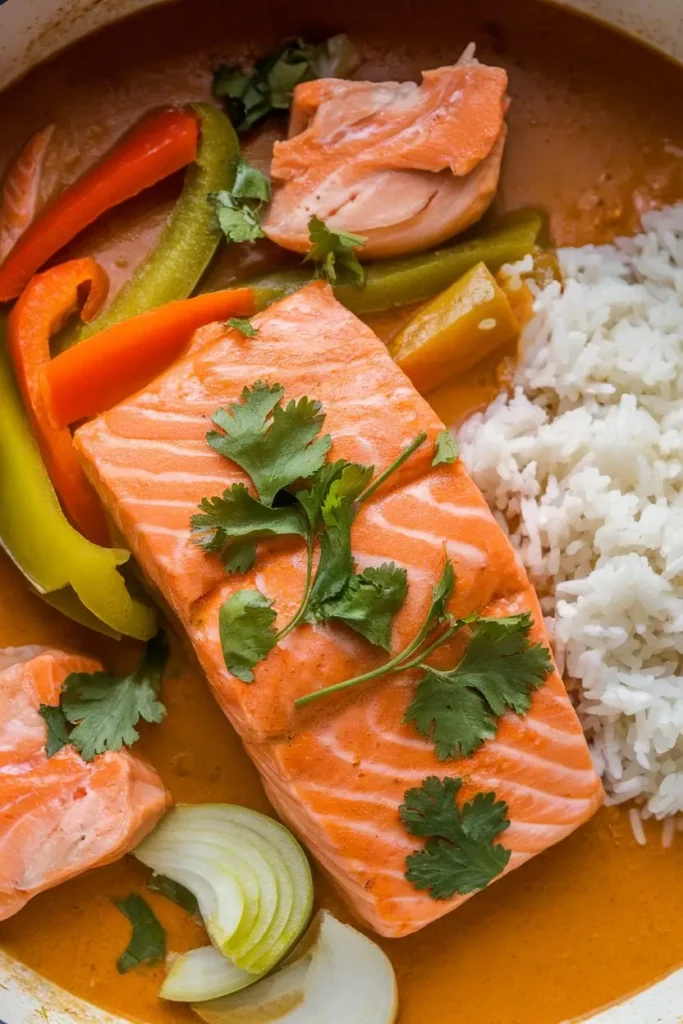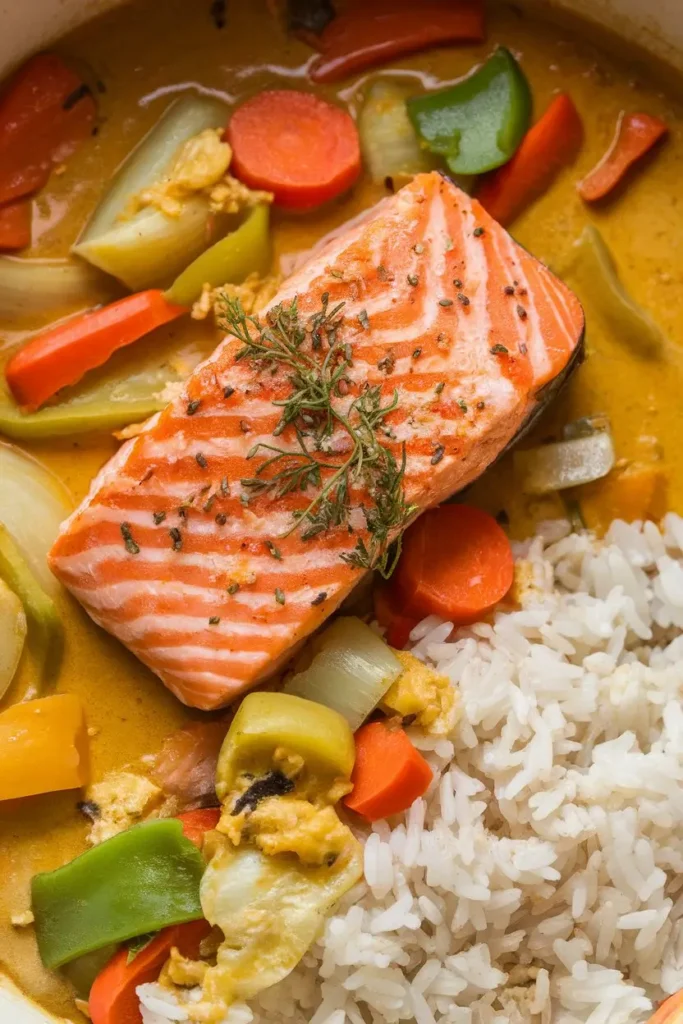How to Perfectly Grill Teriyaki SalmonCreamy, fragrant, and fast enough for a weeknight, salmon coconut curry brings restaurant-level flavor home without fuss.
Introduction
Did you know meals that deliver 30 to 35 grams of protein are linked with better satiety and weight management in multiple nutrition studies? What if a single skillet of salmon coconut curry checked that box, delivered omega-3s, and came together in about half an hour?
This recipe balances bold flavor with smart technique. You get tender, silky salmon, a rich coconut milk sauce, and a bright finish of lime and herbs. The result tastes like a Thai-inspired classic, yet it is easy to adapt for different spice levels, gluten-free or dairy-free needs, and various sides like jasmine rice, rice noodles, or cauliflower rice. If you want a one-pot meal that feels special but cooks quickly, salmon coconut curry is a strong choice.
Along the way, you will find subtle layers from ginger and garlic, a hint of lemongrass or lime, and enough heat to keep things interesting. You can dial it from mild to spicy, fold in your favorite vegetables, and end with a lush sauce that begs to be spooned over rice.
Ingredients for Salmon Coconut Curry
Aromatic, colorful, and flexible, these ingredients create a silky curry that hugs every bite of fish.
- Salmon fillets: 1.25 to 1.5 pounds, skin removed, cut into large chunks
- Ideal: wild-caught salmon for higher omega-3s and a clean flavor
- Swap: steelhead trout or Arctic char if salmon is not available
- Coconut milk: 1 can (13.5 to 14 ounces), full-fat for creaminess
- Lighter option: light coconut milk plus 1 tablespoon coconut cream for body
- Red curry paste: 2 to 3 tablespoons
- Adjust heat: 1.5 tablespoons for mild, 4 tablespoons for spicy
- Alternatives: yellow curry paste for a gentler profile, or massaman for warming spices
- Aromatics
- Yellow onion: 1 small, thinly sliced
- Garlic: 3 to 4 cloves, minced
- Fresh ginger: 1.5 tablespoons, minced or grated
- Lemongrass: 1 stalk, bruised and cut in half, or 1 teaspoon lemongrass paste
- Optional: 1 teaspoon ground turmeric for color and anti-inflammatory benefits
- Vegetables
- Bell pepper: 1, thinly sliced
- Baby spinach: 3 cups, or bok choy, snap peas, or zucchini
- Liquids and seasoning
- Fish sauce: 1 to 2 tablespoons
- Soy sauce or tamari: 1 tablespoon
- Brown sugar, coconut sugar, or maple syrup: 1 to 2 teaspoons to balance heat
- Lime juice: 1 to 2 tablespoons, plus more to taste
- Low-sodium broth or water: 0.5 cup to loosen the sauce if needed
- Oil: 1 to 2 tablespoons neutral oil or coconut oil
- Fresh herbs and garnish
- Cilantro and scallions, chopped
- Lime wedges
- Optional crunch: toasted coconut flakes, cashews, or peanuts
- Optional heat: chili oil, crushed red pepper, sambal oelek, or sriracha
Flavor note: Red curry paste brands vary. Mae Ploy and Maesri run hotter and more concentrated than some American grocery brands. Start with less and build.
Timing
- Prep time: 10 to 15 minutes
- Cook time: 15 to 18 minutes
- Total time: 25 to 30 minutes
Many salmon coconut curry recipes average 35 to 40 minutes. This version finishes faster by cutting the fish into larger chunks that cook gently in the sauce while you finish seasoning and greens.
If you plan to serve with jasmine rice, start the rice first. A standard pot of jasmine rice takes about 15 minutes, which lines up well with the curry cook time.
Time comparison tips
- Instant Pot approach can be similar or slightly faster, though stovetop offers better control over doneness.
- If you are using thicker salmon steaks, add 2 to 3 minutes to the cook time.

Step-by-Step Instructions
Step 1: Prep your salmon and aromatics
Pat salmon dry and cut into 2-inch pieces. Sprinkle with a pinch of salt. Thinly slice the onion, mince garlic and ginger, and prepare bell pepper and greens. Bruise the lemongrass by tapping with the back of a knife.
Pro tip: Larger salmon pieces stay tender and are less likely to break apart in the sauce.
Step 2: Build a fragrant base
Warm oil over medium heat in a deep skillet, saute pan, or Dutch oven. Add onion and a pinch of salt. Cook 3 to 4 minutes until translucent. Stir in garlic, ginger, and lemongrass. Cook 30 to 45 seconds until aromatic.
Tip: Keep heat moderate to avoid scorching the garlic. You want gentle sizzle, not browning.
Step 3: Wake up the curry paste and spices
Stir in red curry paste and turmeric. Cook 60 to 90 seconds, stirring often. This step brings out deeper flavor.
If the paste starts to stick, splash in a tablespoon of coconut milk to loosen.
Step 4: Create the sauce
Pour in coconut milk and whisk or stir to combine with the paste. Bring to a light simmer. Add fish sauce, tamari or soy sauce, and sugar. Taste the sauce now and adjust salt or sugar to balance heat and richness.
Texture check: If you prefer a looser curry, add 0.25 to 0.5 cup low-sodium broth or water.
Step 5: Simmer vegetables
Add bell pepper and simmer 2 to 3 minutes to soften slightly. If using sturdier vegetables like carrots, add them earlier. If using quick-cooking greens like spinach, wait until Step 7.
Step 6: Poach the salmon gently
Reduce heat to medium-low. Slide salmon pieces into the sauce in a single layer. Simmer 5 to 7 minutes, turning once halfway. The salmon should turn opaque and just begin to flake.
Doneness cue: A thermometer should read about 120 to 125 F in the center for medium. Residual heat will carry it a touch higher off the stove.
Step 7: Finish with greens, lime, and herbs
Fold in spinach until wilted. Remove lemongrass. Add 1 to 2 tablespoons lime juice. Taste and adjust: more lime for brightness, a dash of fish sauce for depth, a pinch of sugar if the heat overshadows the coconut.
Top with cilantro and scallions. Add optional garnishes like toasted coconut or chili oil.
Step 8: Serve hot
Spoon salmon coconut curry over jasmine rice, basmati rice, or rice noodles. Offer lime wedges at the table and a small dish of chili paste for anyone who wants extra heat.
Nutritional Information
The values below are estimates per serving for a 4-serving recipe made with full-fat coconut milk and 1.5 pounds of salmon. Actual values vary by brand and portion size.
| Nutrient | Amount per serving |
|---|---|
| Calories | 520 |
| Protein | 34 g |
| Total Fat | 34 g |
| Saturated Fat | 18 g |
| Omega-3s (EPA+DHA) | 1.6 to 2.4 g |
| Carbohydrates | 16 g |
| Fiber | 3 g |
| Total Sugars | 6 g |
| Sodium | 820 mg |
| Vitamin D | 450 to 600 IU |
| Vitamin B12 | 4 to 5 mcg |
| Potassium | 900 to 1000 mg |
Data insights:
- A 6-ounce portion of wild salmon typically provides roughly 1.5 to 2.0 grams of EPA and DHA combined, based on USDA and seafood nutrition data.
- Vitamin D content in salmon varies widely by species and farming method, often covering a large share of daily needs.
- The sodium range assumes fish sauce and tamari; low-sodium options drop that number significantly.
Healthier Tweaks Without Losing Flavor
Small adjustments can make this salmon coconut curry lighter while keeping the texture lush.
- Use light coconut milk plus 1 tablespoon coconut cream. This trims calories and saturated fat while keeping a silky mouthfeel.
- Cut oil to 1 teaspoon when sweating the onions. A splash of water can help prevent sticking.
- Boost veggies: double the spinach, add mushrooms or zucchini, or fold in broccoli florets for more fiber and volume.
- Swap tamari for low-sodium tamari. Combine with fresh lime and herbs to reduce reliance on salt.
- Balance heat with fruit instead of sugar: diced pineapple or mango lends a natural sweetness that pairs well with red curry.
- Serve over cauliflower rice or steamed shredded cabbage for a lower carb base.
- Dairy-free and gluten-free by default when using tamari instead of soy sauce.
- For a leaner protein variation, try cod, shrimp, or extra-firm tofu. Keep the same sauce and adapt timing.
Serving Suggestions for Salmon Coconut Curry
This curry welcomes multiple sides and textures.
- Steamed jasmine rice for classic comfort
- Basmati rice for a fluffy, fragrant base
- Rice noodles to catch every drop of sauce
- Quinoa for a nutty, protein-rich pairing
- Cauliflower rice for a lighter bowl
- Roti or naan for scooping, if you are not keeping it gluten-free
- Quick cucumber salad with rice vinegar and a pinch of sugar to cut through richness
Garnish ideas:
- Fresh herbs: cilantro, Thai basil, or mint
- Zest and juice of lime for brightness
- Crunch: toasted coconut flakes, crushed cashews, or peanuts
- Heat boosters: chili crisp, sambal oelek, or a drizzle of sriracha
Drink pairings:
- Crisp lager or a light pilsner
- Off-dry Riesling or a chilled rosé
- Sparkling water with lime and a pinch of sea salt
Common Mistakes to Avoid
- Overcooking salmon: Small cubes cook too fast and flake apart. Cut larger pieces and simmer gently. Aim for medium doneness.
- Skipping the paste blooming step: Curry paste needs 60 to 90 seconds in oil to wake up flavor.
- Curdlings or greasy texture: Boiling the coconut milk hard can separate the fat. Keep a gentle simmer.
- Unbalanced seasoning: Taste the sauce before adding salmon. Adjust salt, lime, and sweetness early, then fine-tune at the end.
- Not accounting for brand heat: Some curry pastes are spicy. Start with less, then add more after tasting with coconut milk.
- Neglecting acid: Lime juice ties flavors together. Without it, the dish can taste flat.
- Using only one vegetable: A mix of bell pepper and greens boosts color, texture, and nutrients.
Storing Tips for Salmon Coconut Curry
- Refrigerate: Cool completely, then store in an airtight container for up to 3 days.
- Freezer: Salmon can toughen after freezing in sauce, though it is still safe. If freezing, undercook the fish slightly and freeze up to 2 months. Reheat gently.
- Reheating: Warm on the stovetop over low heat until just hot, not boiling. Add a splash of water or coconut milk if the sauce thickens in the fridge.
- Make-ahead: You can prep the sauce base through Step 4 and refrigerate for 2 days. When ready to eat, bring to a simmer, add vegetables and salmon, and finish fresh.
- Rice and noodles: Store separately to avoid sogginess.
Cook, Share, Subscribe
Silky coconut sauce, tender salmon, and vibrant aromatics in about 30 minutes. Give it a go, then share your spin in the comments or review section. If you enjoyed this, subscribe for recipe updates and smart weeknight ideas.
FAQs
Q: Can I use frozen salmon? A: Yes. Thaw in the fridge overnight or under cold running water in a sealed bag. Pat dry thoroughly before cooking to help the sauce cling and to avoid diluting flavor.
Q: Skin on or skin off? A: Skin-off is easier for poaching in sauce. If yours has skin, sear skin-side down first in a separate pan until crisp, then slide portions into the curry at the end for a few minutes.
Q: What curry paste should I buy? A: Maesri and Mae Ploy are reliable and widely available. They run fairly spicy, so start with a smaller amount and add more to taste once the coconut milk is in.
Q: Can I make it mild for kids? A: Use 1 to 1.5 tablespoons of a mild red or yellow curry paste and skip extra chilies. Balance with a touch more coconut milk and a little sugar. Lime at the end keeps it bright.
Q: How do I make it dairy-free and gluten-free? A: Use full-fat or light coconut milk, which is naturally dairy-free, and choose tamari instead of soy sauce. Most red curry pastes are gluten-free but always check labels.
Q: How can I thicken a thin curry? A: Simmer uncovered for a few minutes to reduce. If you need extra help, stir 1 teaspoon cornstarch with 2 teaspoons water and add to the simmering sauce. Keep it light so the sauce stays glossy.
Q: What if I only have light coconut milk? A: It works. For richer texture, add 1 tablespoon coconut cream or finish with a knob of coconut oil. Monitor salt since lighter coconut milk can taste less rounded.
Q: Can I swap salmon for tofu or shrimp? A: Yes. For tofu, use extra-firm, press well, and simmer 5 to 7 minutes. For shrimp, add in the final 3 to 4 minutes until pink and opaque. The sauce stays the same.
Q: Is there an Instant Pot version? A: Sauté aromatics and curry paste on Sauté mode. Add coconut milk and seasonings, then nestle in salmon pieces. Pressure cook on Low for 1 minute, quick release, and stir in greens and lime. The stovetop version gives more control, but Instant Pot is handy.
Q: What sides pair best? A: Jasmine rice is classic, rice noodles are slurpable, and cauliflower rice keeps it lighter. Add a crisp cucumber salad or quick-pickled carrots for contrast.
Looking for more ideas after salmon coconut curry? Try a chicken coconut curry using the same sauce base, a vegetable-forward yellow curry with sweet potato and chickpeas, or a bright lemongrass-lime broth with shrimp and bok choy.


